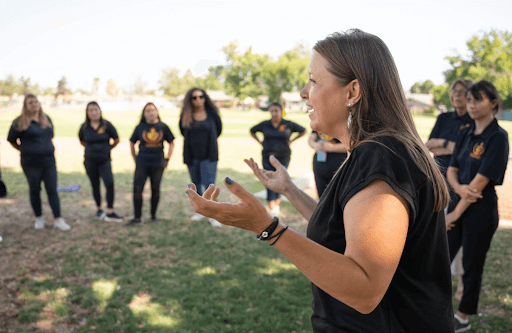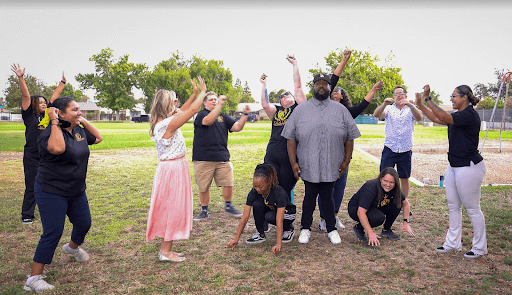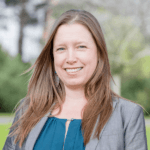I first understood that something was very wrong when I saw that the 2015 Sustainable City pLAn had exactly zero mentions of K–12 education in it, despite its focus on “Transforming Los Angeles: Environment, Economy, Equity.” My professor, the first chief sustainability officer for the city of Los Angeles, told me it was because he and the other authors of the plan just did not believe the public school system could or would do anything meaningful to address any of these three issues. The team certainly didn’t think schools could do anything quickly enough to address climate change. In my work here at Ten Strands, I hope to change this view—and to help transform California’s educational system into a key player in our fight for environmental justice and planetary survival.
I think I was caught by surprise about the plan’s dismissal of education because of the success I’d had at Environmental Charter Schools for the previous 10 years. Serving primarily Black and Latino students in South Los Angeles, this public charter school network grew organically through family demand for deeper learning in safe spaces. As a teacher, coach, administrator, school co-founder, and curriculum director, I saw how teachers working with community-based partners could create rigorously standards-based interdisciplinary units that led to place-based civic engagement projects. I saw thousands of students graduate college-ready and empowered to be stewards of their communities. I saw how in two short years, a school campus could be transformed from a prison vibe to an oasis through student-led projects related to food, water, and waste. I witnessed how learning in and about our local environment connected content in each discipline and supported students to interrogate our country’s history of systemic environmental racism, settler colonialism, and radical inequalities in educational opportunities. I learned how incredibly simple it was for us as school leaders to allocate funding for overnight outdoor education trips for every student every year in our Local Control and Accountability Plans. Most importantly, I understood the role of schools in working with outdoor educators to create culturally responsive learning experiences where kids and teachers from all backgrounds could thrive when given the chance to connect with and to care for nature.

For many years, we tried to expand our model through our Green Ambassadors professional learning institutes. Teachers from all over Southern California would engage with our unit design cycle to develop inquiry and action projects focused on what they experienced daily. Time and again, kids’ and teachers’ efforts at other schools were thwarted when their districts stopped even the simplest of solutions like small gardens, rain barrels, or composting. I was left frustrated with local district policies, but it wasn’t until I began working at Ten Strands in 2018 that I understood how widespread and deeply rooted the disconnects are among environmental education, sustainable practices, and the pressure educational leaders are under to provide not just academic support, but often wraparound services for entire communities.
As tensions among these competing priorities were exacerbated by the pandemic, there also emerged some clarity about the potential for embracing a more holistic approach to education—and making the most of such moments is one of the things I appreciate most about Ten Strands. Within months, we worked with partners to launch the COVID-19 National Outdoor Learning Initiative. As educators developed and used this huge resource library and spent more time with students outdoors, they helped build the case for greening school campuses—to provide spaces for learning, to help students’ emotional well-being by connecting them with nearby nature, and to actually reduce negative health impacts of air pollution and urban heat islands.
Thanks in part to the persistence of members of the California Environmental Literacy Initiative’s innovation hubs, policy makers are increasingly seeing the potential to invest in solutions that address multiple problems at once. For example, this year’s state budget appears to include tens of millions of dollars for programs that will help CalFire create more urban forests on campuses vulnerable to extreme heat. Los Angeles Unified School District (LAUSD), where I received a largely excellent education, has dramatically expanded access to residential outdoor schools for its highest needs students and is replacing asphalt on school playgrounds.
These operational upgrades are taking place alongside investments in curriculum and instruction, such as LAUSD’s board resolution and creation of a climate literacy task force. On a larger scale, the state’s investment in the Climate Change and Environmental Justice Project has brought Ten Strands into collaboration with an inspiringly diverse cadre of curriculum writers who will create open educational resources addressing local phenomena. As campuses become more natural and students have increased access to green spaces, near and far, educational programming will increasingly build a sense of connectedness with nature—one of the strongest predictors of later stewardship behaviors.


So, as recent reports such as the Aspen Institute’s K12 Climate Action Plan and the North American Association for Environmental Education’s Mapping the Landscape of K–12 Climate Change Education Policy in the United States recommend, California’s education system is indeed embracing its solutionary role in creating both healthier communities and more empowered citizens. As Ten Strands’ Director of Strategic Partnerships, it is an honor and a pleasure every day to work alongside our growing staff and incredible partners to not just re-imagine, but to actively manifest the future we all have the responsibility to create. By strengthening increasingly interconnected networks of educators and their allies, I believe that schools will soon become essential sites of transformational, sustainable change.

